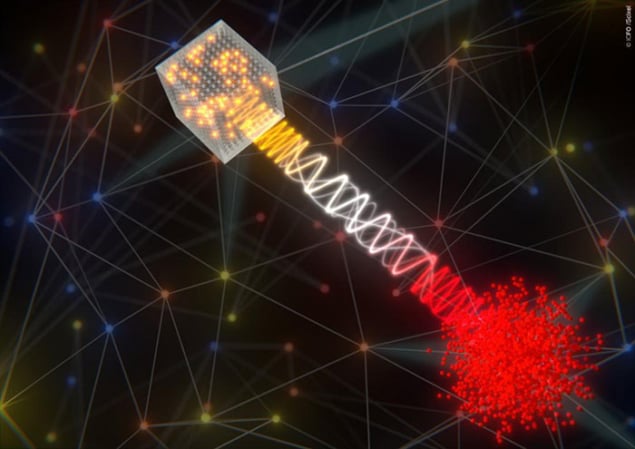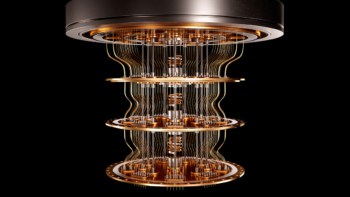
Quantum information has been transferred between a cold atomic gas and a solid crystal using photons. The work was done by Nicolas Maring and colleagues at the Institute of Photonic Sciences and the Barcelona Institute of Science and Technology and could lead to significant advances in quantum computing and even the creation of a “quantum internet”.
An important challenge in building a quantum computer is how to transfer quantum bits (qubits) of information between the “quantum nodes” of a system. These nodes can consist of a variety of different types of matter, including cold atomic gases and solid crystals doped with impurities. If two nodes are the same, it is relatively straightforward to transfer qubits – in the form of single photons, for example. In this process, one node emits a qubit-encoded photon that is then absorbed by another node.
“It’s like having nodes speaking in two different languages,”
Nicolas Maring, Institute of Photonic Sciences
In practical quantum communication systems, it is often better to use different types of quantum nodes to perform different functions. This is because some nodes are better than others at doing certain tasks. Cold atomic gases can easily produce qubit-encoded photons, for example, while doped solids can store quantum information over relatively long periods of time. However, different types of nodes will usually emit and process photons at different wavelengths and bandwidths, making qubit transfer between nodes more difficult.
“It’s like having nodes speaking in two different languages,” explains Maring. “In order for them to communicate, it is necessary to convert the single photon’s properties so it can efficiently transfer all the information between these different nodes.”
Laser-cooled atoms
In the ICFO study, a “hybrid” quantum network link between two different quantum nodes in separate labs was established for the first time. The first node, a gas of laser-cooled rubidium atoms, produced a qubit-encoded photon with a wavelength of 780 nm. The photon’s wavelength was then converted to 1552 nm, and coupled to a commonly-used optical telecommunication fibre, to be carried into the next lab.
After passing through the fibre, the photon was converted again to a wavelength of 606 nm. This enabled its quantum information to be processed by a second quantum node, which was composed of a crystal doped with praseodymium ions. This node could store qubits for 2.5 μs while retaining most of the original quantum information.
The research could prove to be a significant step towards the creation of quantum networks that take advantage of the different processing and storage capabilities of different quantum nodes. In the future, the ICFO scientists hope that larger scale, more complex hybrid networks will be built, made from many different nodes and links between them.
Huge variety
“Much like the modern-day Internet connects a huge variety of very different devices, the future quantum internet will necessarily have to connect many different quantum information processing devices that each have their own advantages and application areas”, Alexey Gorshkov of the University of Maryland tells Physics World. “This work from the ICFO is a significant step in the direction of creating such a quantum internet”.
The research is described in Nature.
- There is much more about new technologies for quantum information in the Physics World Discovery book How to Build a Quantum Computer, which is free to read



